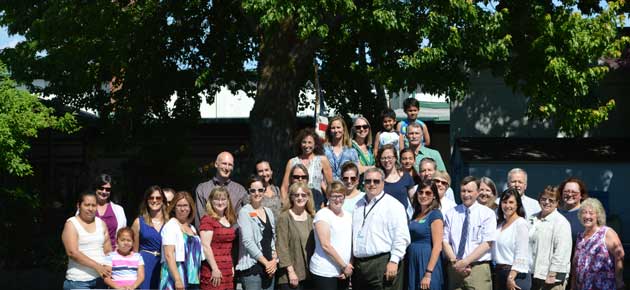
This Oregon Solutions project team was part of ongoing efforts to reduce childhood obesity in Wasco County. Initial work began in 2013 with the measurement of percentile BMls of children in one public elementary school in The Dalles. Higher than state average overweight and obesity rates were noted, which prompted additional inquiry. A Columbia Gorge Health Council (CCO) transformation grant was obtained through Pacific Source Community Solutions, to study the BMI percentiles of the three largest elementary schools in The Dalles. Those results again showed higher than state and national averages of overweight and obese children. The grant proposal was then revised from implementing a specific intervention aimed at parental education and increasing physical activity, to a much broader attempt to inform local leaders of the scope and intensity of the problem, and development of a coalition.
The Oregon Solutions project team was charged to “create a community action plan that enables public sector, private sector, and nonprofit organizations to agree on shared outcomes and coordinate team members’ specific activities.” The community action plan to reduce childhood obesity hoped to ultimately involve actions making an impact at three levels: culture, policy and regulation.
Governor’s Designation Letter (PDF)
Declaration of Cooperation (PDF)
Problem Statement
The rate of childhood obesity in Wasco County exceeded both the state and national levels. More than one in three children in Wasco County were clinically obese, meaning they had a body mass index, or BMI, greater than the eighty-fifth percentile. Perhaps for the first time in the county’s history, their children would not have a healthier life than their parents nor would they likely live as long. This Oregon Solutions project team was dedicated to reducing childhood obesity in Wasco County. The project team committed to creating a healthier built environment for their children’s sake; educating and informing the community to change community norms around the importance of proper nutrition and being active; and working collectively and collaboratively to change the things they can within their own organizations and within the community to reduce the likelihood of childhood obesity.
Objectives
The coalition’s many activities mirrored the Robert Wood Johnson Foundation’s five approaches to reducing childhood obesity. They were as follows:
- Ensure all children enter kindergarten at a healthy weight.
- Make a healthy school environment the normal and not the exception across the United States.
- Make physical activity a part of the everyday experience for children and teens.
- Make healthy foods and beverages the affordable, available, and desired choice in all neighborhoods and communities.
- Eliminate the consumption of sugar sweetened beverages among 0-5 year olds.
Coalition member organizations engaged in a variety of existing anti-childhood obesity activities and began new efforts. The Declaration of Cooperation commitments illustrate these activities.



